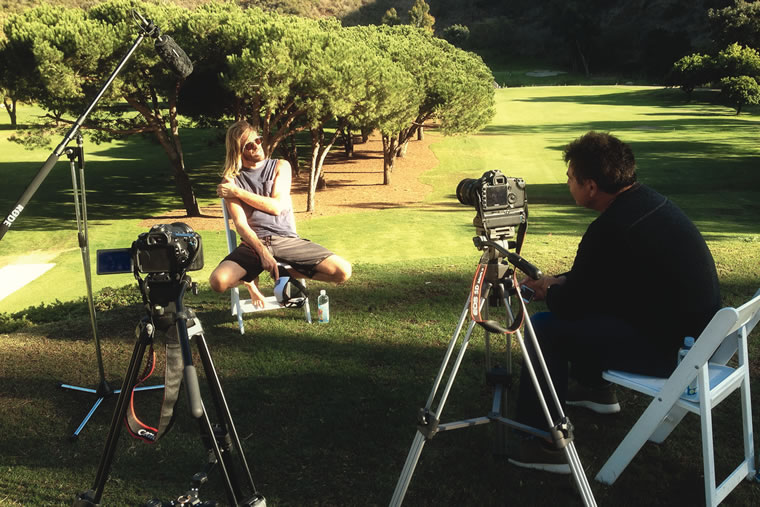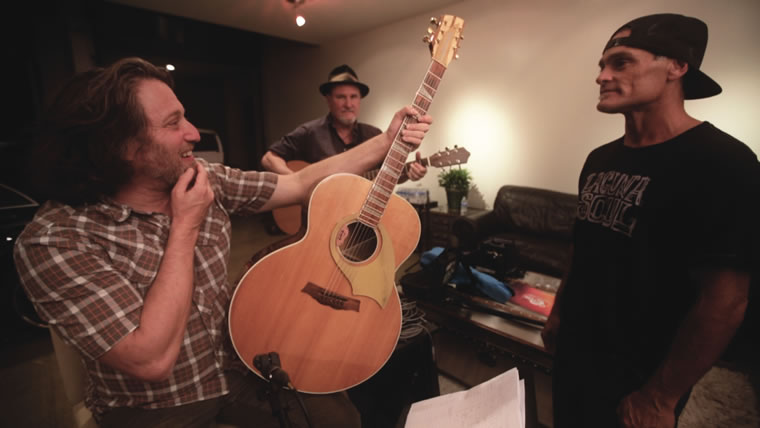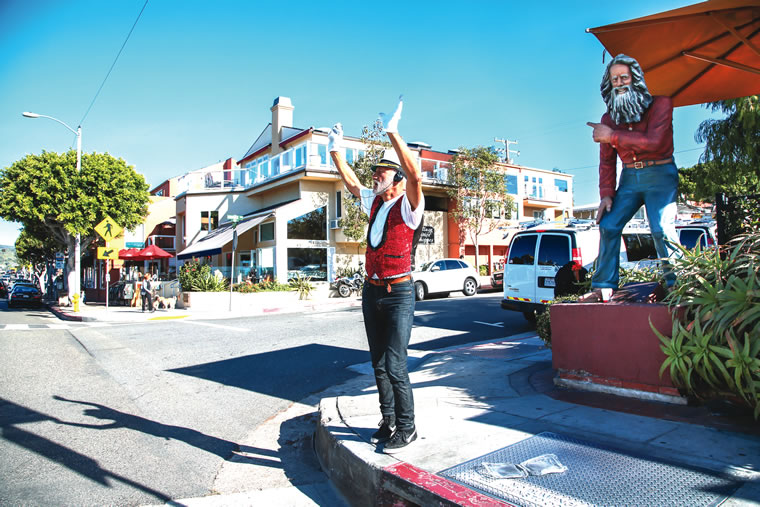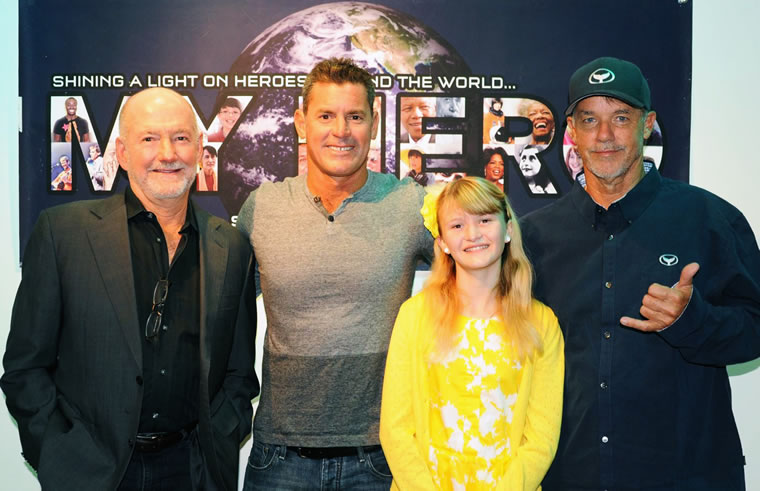
Clay Berryhill is sitting in his home studio, showing a visitor an extended clip from his two-years-in-the-making documentary film “133 The Road to Laguna,” about the formation and musical evolution of a band made up of some of the city’s most locally famous musicians.
One of the producers of “133,” Clay watches his movie flutter across a high-definition monitor. He’s bopping his head up and down during music sequences, and poring over each minute detail, from the color correction to the sound mix to the cinematography. Even though he’s probably viewed this footage more than 100 times, the wide-eyed excitement he’s feeling at this moment makes him appear as if he’s seeing it all for the very first time.
“This is my first film, and you only get one chance to make a first impression,” Clay says. “It’s such a personal project for me, and I really want to do good by these guys who are in it.”
Clay and several other filmmakers are part of a recent Laguna Beach documentary film surge, one that’s seen such notable shorts and features as Jason Blalock’s “Sawdust and Sand: The Art of Douglas Miller,” James Chu’s “KelpFest: A Celebration” and Anthony Liuzzi’s “Shorebreak: The Evolution of Skimboarding.” A much-anticipated doc from director William Kirkley on Laguna’s legendary Brotherhood of Eternal Love, “Orange Sunshine,” is currently in production.
It’s clearly a ripe time to be a documentary maker in the city. Affordable and accessible technology, like high-quality smartphone cameras and remote-controlled aerial drones, have broadened the range of what can be done with the form, and who can get involved. First-time filmmakers are shooting substantial pieces on social and environmental issues, as well as profiling unique individuals with stories to tell.
“There are a lot of people making films here now, where 40 years ago I may have been the only one,” says Greg MacGillivray, who’s produced much-lauded nature and environmental Imax films from his Laguna-headquartered MacGillivray Freeman Films for decades. “In the 1970s, there weren’t that many filmmakers around here. But now, there are hundreds. Maybe even thousands.”
Making the Band

Back in the studio, Clay admits to being a local music obsessive. He came up with the notion of bringing together such admired Laguna Beach players as Jason Feddy, Nick Hernandez, Steve Wood and others with two purposes. First, to tell the story of how a band is formed, from the initial idea to the songwriting phase, to recording, to playing its first live gig. Second, to show people outside the city what a hotbed of talent there is in a small town that some people around the world may only know of from bad reality TV.
That’s the premise of “133 The Road to Laguna,” which Clay expects to wrap up by the end of the year with the help of co-producer Erik Spicard, who also serves as cinematographer and film editor. The two men are collaborating on scenes that will make the final cut and hope to tour “133” on the film festival circuit and beyond. “And maybe, fingers crossed, the film will give these musicians a following that goes beyond a crowded nightly set list at the Sandpiper or Marine Room,” Clay says.
While it’s a given that locals will love the film—the musicians are their friends and neighbors, after all—the trick is to get people living outside the city limits to care. To help lure that audience, “133” features interviews with international legends like Foo Fighters drummer Taylor Hawkins, a Laguna Beach High School alum.
“I wanted to do this because there’s a story to be told about a small town with a big heart, about the music and musicians of Laguna Beach, Calif., in a band called 133,” Clay says. “And in another sense, it also tries to answer the question, what is it about this tiny little town that attracts such a unique population of artists and musicians?
“I think people will find it interesting because a lot of documentaries are about what’s happened in the past, but our story almost plays out in real time,” he continues. “The band is out there right now playing gigs at Mozambique each month, and people can come and check them out after they see the film. In a way, this is sort of our real reality show, and a better one.”
Meeting and Greeting

Like Clay, Martin Yewchuk is another first-time filmmaker who stumbled upon a great documentary idea—or, more accurately, drove past a great idea. That’s how Martin first encountered Michael Minutoli, dancing and waving to passersby as he does each day on the corner of Coast Highway and Brooks Street, the latest in a 125-year-long line of Laguna Beach greeters.
“On a whim, I picked up a camera, and I was looking for a subject,” says Martin, a former professional hockey player. “Michael seemed like the perfect person. Lots of people were stopping to film and photograph him, so I asked if I could interview him. That’s when I began learning about the whole history of the greeter.”
Martin now has a documentary—“The Greeter,” released in March—that tells the story of all the greeters, both “official” and not, and the controversy over who gets to hold that title.
“That’s part of the movie, and you can’t avoid that topic,” Martin says. “Some people told me up front that they would talk about Eiler Larsen [Laguna Beach’s former official and most widely-known greeter], but they won’t discuss Michael. I asked them why and they told me they just don’t like him. But what I found was, people tried to kick Eiler out of town many times, but he persevered and greeted people for 35 years. People would complain about Eiler and tell him to tone it down, but he felt that was his calling.”
Martin’s film might force some to ask themselves a particularly hard question: Who could possibly have a problem with someone, be it Eiler or Michael, who only wants to spread happiness by waving hello at people?
“I thought I was going to make a film that was more about the greeter, but it ended up being so much more,” he says. “It’s about his effect on the people in Laguna Beach, but also how the greeter affected the whole world, because so many people come through Laguna. Eiler Larsen greeted millions of people, and that’s been surprising—to see how much of an impact he made and how many people remember him.”
Martin knows that a subject like the greeter is a very Laguna Beach-centric story, but he sees the theme as being far more a universal tale.
“Spreading love and joy and peace and acceptance is a worldwide subject, and that’s what all these greeters have done, in a way that’s very simple and powerful,” he says. “The film is about people dedicating their lives to making other people’s lives better, but in a totally unique way. These guys really enjoy what they’re doing, and they’ve brought a lot of joy to the people they encounter and remind us there’s more to life. And really, if people aren’t in the same groove as Michael, if he’s doing something that bugs them, then they need to take a closer look at themselves and ask why they feel that way. That’s why this documentary is important.”
Eco Educators

Debuted earlier this year, “Laguna Beach Eco Heroes” is something of an all-star documentary highlighting many of the city’s environmental and nature preservation organizations: Laguna Bluebelt Coalition, Pacific Marine Mammal Center, Laguna Canyon Foundation, ZeroTrash Laguna and several others, as well as the people behind them. At an easily digestible 30 minutes, the film is a nice introduction to the history of environmental issues in Laguna Beach that have shaped the city.
Many of the people spotlighted in the film are familiar to locals—Laguna Greenbelt founding father James Dilley, artist Wyland and “Kelp Lady” Nancy Caruso among them. It was directed by Jeanne Meyers, co-founder of the My Hero Project, which uses short films shot by students and social activists to educate the public about a wide range of issues. This particular film took a different route than most documentaries in that the goal was to get it seen not in traditional theaters, but instead on the Internet and television—and it’s achieved that. It aired on Cox cable through early October and is available online at myhero.com/lagunaecoheroes.
“We’re hoping that Cox will archive it and make the film available to the beachside resort hotels,” Jeanne says. “It’s a great introduction to Laguna Beach, and a great overview of the many different environmental organizations in the city. If we don’t educate the tourists that come to Laguna, then we’re in trouble.”
“A really good documentary can inspire activism, especially when [viewers] see people taking action, giving their own time and trying to make a difference.” – Wendy Milette
At the very least, “Laguna Beach Eco Heroes” could get some of the city’s 3 million annual visitors to think twice about taking home souvenirs lifted from the tide pools, or remind them to leave nothing but footprints during a long canyon hike. For residents, it may serve as a motivator to get involved in local environmental causes.
“A really good documentary can inspire activism, especially when [viewers] see people taking action, giving their own time and trying to make a difference,” Jeanne says. “Our hopeful outcome is that people who see ‘Laguna Beach Eco Heroes’ become more active in whatever way they can, whether it’s planting trees, using less water, whatever.”
In short, it’s a perfect meshing of art and education. “Laguna Beach is an art community, and filmmaking is one of the highest arts, in our opinion,” says My Hero Project’s Wendy Milette. “So it doesn’t surprise me that there’s a lot of documentary filmmaking going on right now. Just the beauty and the nature that’s preserved here, that’s kind of our story. It’s very inspiring when you have beautiful green hills to look at, and a clean coastline.”
Greg, whose One World One Ocean campaign was featured in “Laguna Beach Eco Heroes,” might be the godfather of all Laguna Beach documentary filmmakers, especially when it comes to using the medium as a means to educate and inspire. While he’s lived in town for many years, he says that Laguna Beach still serves as constant inspiration for his documentary projects.
“We’re still finding new things to see and experience in Laguna Beach, and you end up incorporating those into the films,” he says. “Now, you can do that about pretty much any place in the world, but Laguna Beach has a great variety of people and ideas, and I love the way that we have always gotten together to try to conquer our problems. It’s a lot like the surveys we’ve done that show that our films have changed people’s attitudes about the ocean and preservation, certainly in part due to the visual imagery that we do with the Imax films by giving the audience the sense of actually being there and immersing them into an environment. … People remember that, and they think, ‘Hey, I want to preserve that.’ That’s what a great documentary can do.”
— Written by Rich Kane




